Hybrid Ray Tracer
Table of Contents
I initially started this project as a spiritual successor to my Vulkan renderer, but eventually decided to keep the scope limited so that I could check out how ray tracing in Vulkan works. Starting the project from scratch also gave me the opportunity to check out the latest features added in Vulkan 1.3 (mainly dynamic rendering), and improve on some abstractions over the Vulkan API.
About the renderer
The renderer is a hybrid ray tracer: it first renders the base geometry in a rasterized pass first, then ray traces the scene for shadows, and finally combines the two outputs together in a combine pass.

Geometry pass
All the geometry pass does is render the scene albedo color to a R8G8B8A8_UNORM render target:
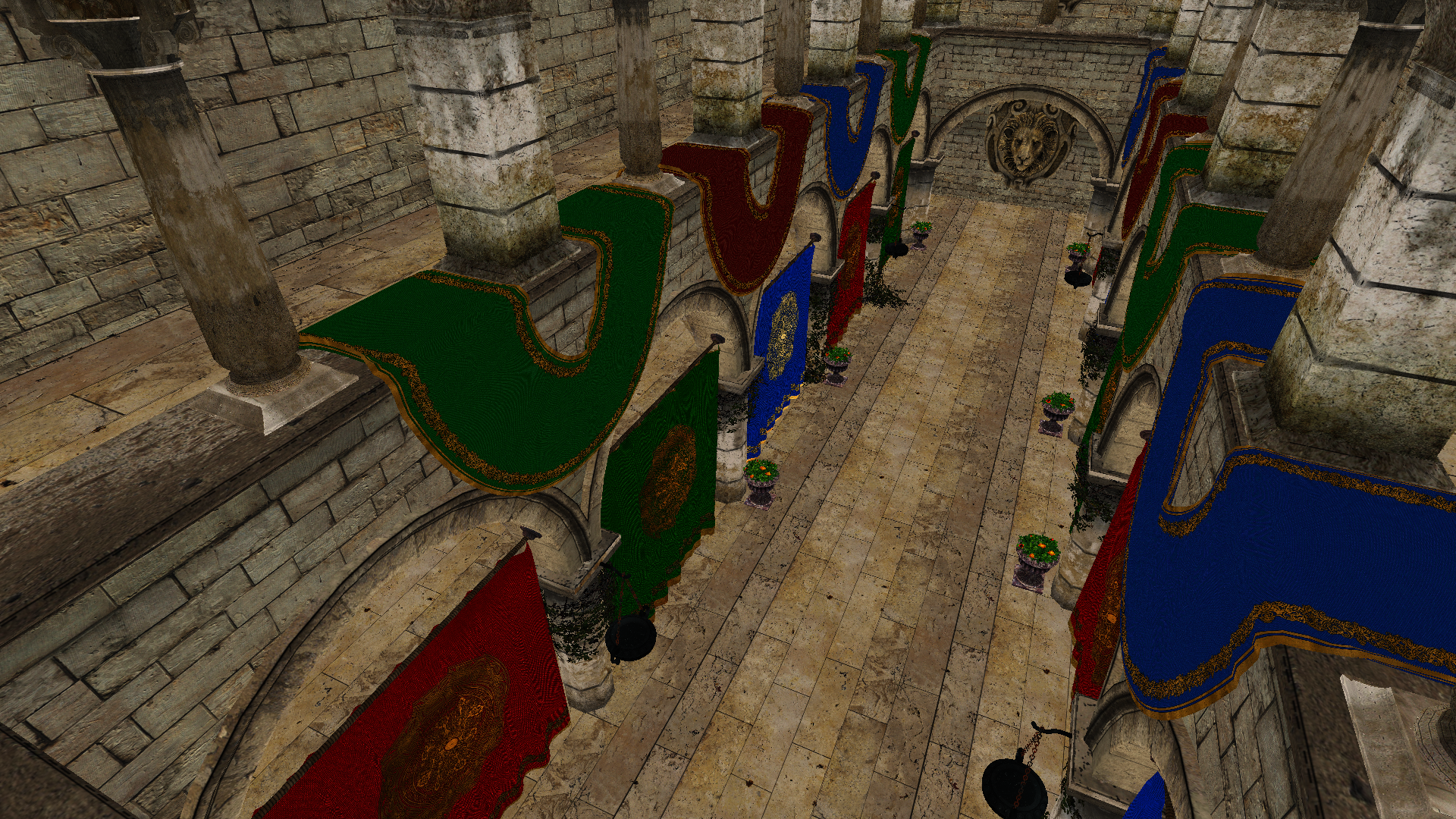
Ray tracing pass
The ray tracing pass traces two rays:
- One from the camera position into the scene, to get the world-position of the corresponding pixel in the scene.
- One from that world-position towards the direction of the sun, with a small offset to simulate soft shadows.
- If this ray hits anything, the pixel is shadowed and a value of
0is written to the output buffer. - If the ray doesn’t hit anything, the pixel is not shadowed and a value of
1is written to the output buffer.
- If this ray hits anything, the pixel is shadowed and a value of
Currently this is simply done at 1 ray per pixel, without any denoising. I have been looking into some denoising techniques, but haven’t gotten around to implementing one yet.
The result is written to a R8_UNORM render target:
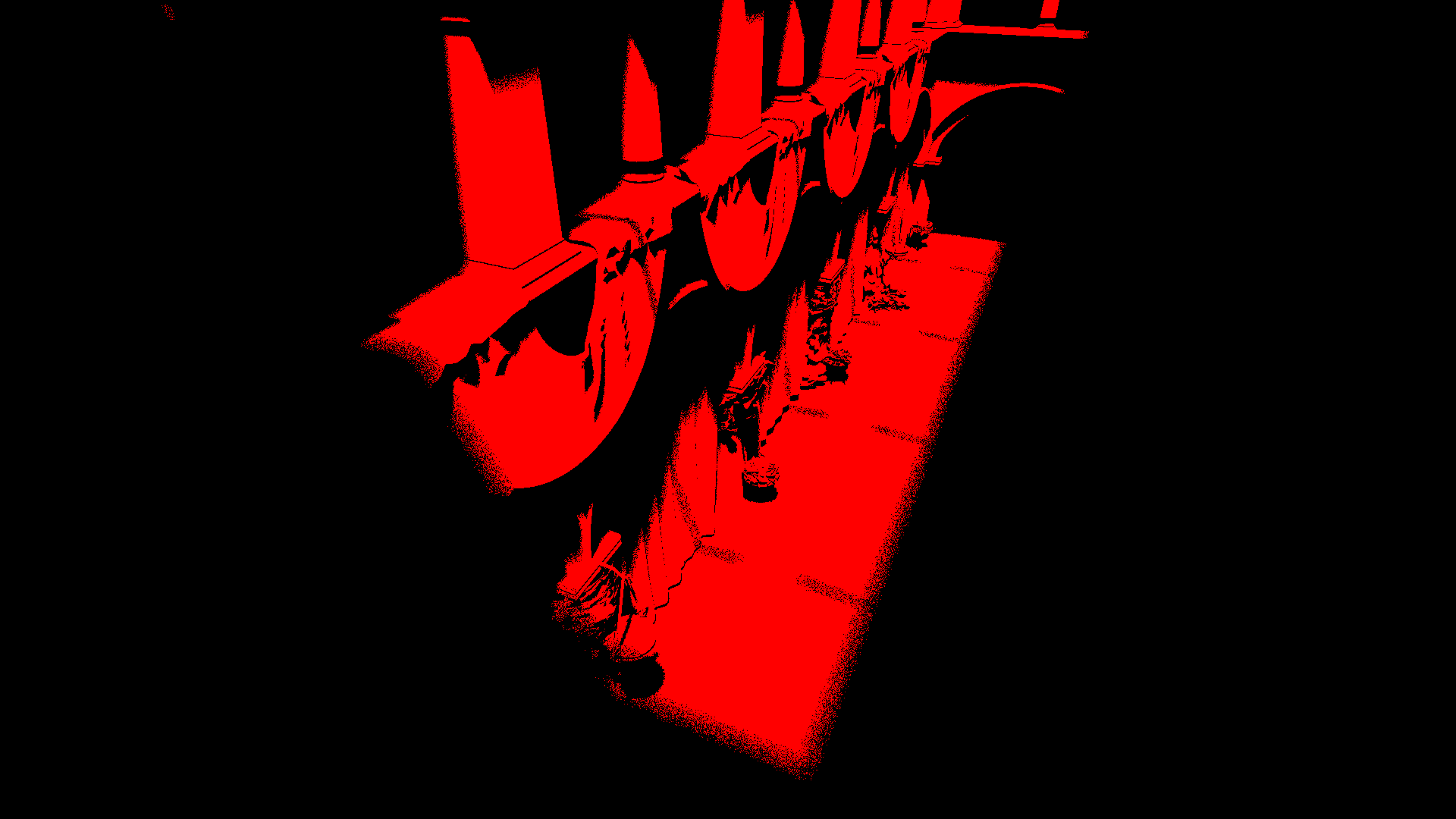
About the ray tracing shaders
This is the payload passed along with the ray. It stores whether the ray is a secondary ray or not, and if it intersected with any geometry.
struct HitInfo
{
bool hitAnything;
bool isSecondaryRay;
};
struct Payload
{
[[vk::location(0)]] HitInfo hitInfo;
};
The ray generation shader spawns rays from the camera into the scene.
After the rays went through the hit or miss shader, the shadow mask for this pixel gets created with the payload of the ray, and stored into the outputImage.
[shader("raygeneration")]
void main()
{
const uint3 launchId = DispatchRaysIndex();
const uint3 launchSize = DispatchRaysDimensions();
// Calculate the world position from the current screen coordinates
const float2 pixelCenter = launchId.xy + float2(0.5, 0.5);
const float2 inUV = pixelCenter / launchSize.xy;
const float2 d = inUV * 2.0 - 1.0;
const float4 origin = mul(camera.viewInverse, float4(0, 0, 0, 1));
const float4 target = mul(camera.projInverse, float4(d.x, d.y, 1, 1));
const float4 direction = mul(camera.viewInverse, float4(normalize(target.xyz), 0));
Payload payload = (Payload)0;
payload.hitInfo.hitAnything = false;
payload.hitInfo.isSecondaryRay = false;
RayDesc rayDesc;
rayDesc.Origin = origin.xyz;
rayDesc.Direction = direction.xyz;
rayDesc.TMin = 0.001;
rayDesc.TMax = 10000.0;
TraceRay(accel, RAY_FLAG_FORCE_OPAQUE, 0xFF, 0, 0, 0, rayDesc, payload);
outputImage[int2(launchId.xy)] = float(!payload.hitInfo.hitAnything) * 1.0;
}
The closest hit shader has two functions:
- Spawn a secondary ray from the hit position in the world, towards the direction of the sun.
- If the ray is a secondary ray, flag it as having hit geometry instead.
[shader("closesthit")]
void main(inout Payload payload)
{
// If this ray is a secondary ray, flag it as having hit geometry and return from the shader.
if (payload.hitInfo.isSecondaryRay)
{
payload.hitInfo.hitAnything = true;
return;
}
// Calculate the origin and direction of the secondary ray that will test for shadows.
// This ray will have a random offset in direction, to simulate soft shadows.
// InitRand credit: Chris Wyman: http://cwyman.org/code/dxrTutors/tutors/Tutor5/tutorial05.md.html
uint randSeed = InitRand(DispatchRaysIndex().x + DispatchRaysIndex().y * DispatchRaysDimensions().x, pushConstants.frameNr);
// GetRandomOnUnitSphere credit: Cory Simon: http://corysimon.github.io/articles/uniformdistn-on-sphere/
const float3 origin = WorldRayOrigin() + WorldRayDirection() * RayTCurrent();
const float3 randomOffset = GetRandomOnUnitSphere(randSeed);
const float3 direction = normalize(normalize(pushConstants.sunDir) * 10.0 + randomOffset * 0.1);
RayDesc rayDesc;
rayDesc.Origin = origin;
rayDesc.Direction = direction;
rayDesc.TMin = 0.001;
rayDesc.TMax = 10000.0;
payload.hitInfo.isSecondaryRay = true;
TraceRay(accel, RAY_FLAG_FORCE_OPAQUE, 0xFF, 0, 0, 0, rayDesc, payload);
}
The miss shader simply flags the ray as not having hit any geometry.
[shader("miss")]
void main(inout Payload payload)
{
payload.hitInfo.hitAnything = false;
}
Composite pass
The combine pass takes the output of the two previous passes and combines them into one output buffer. It’s a very simple pass which:
- darkens the areas which are in shadows
- applies gamma correction
The result of the combine pass looks like this:
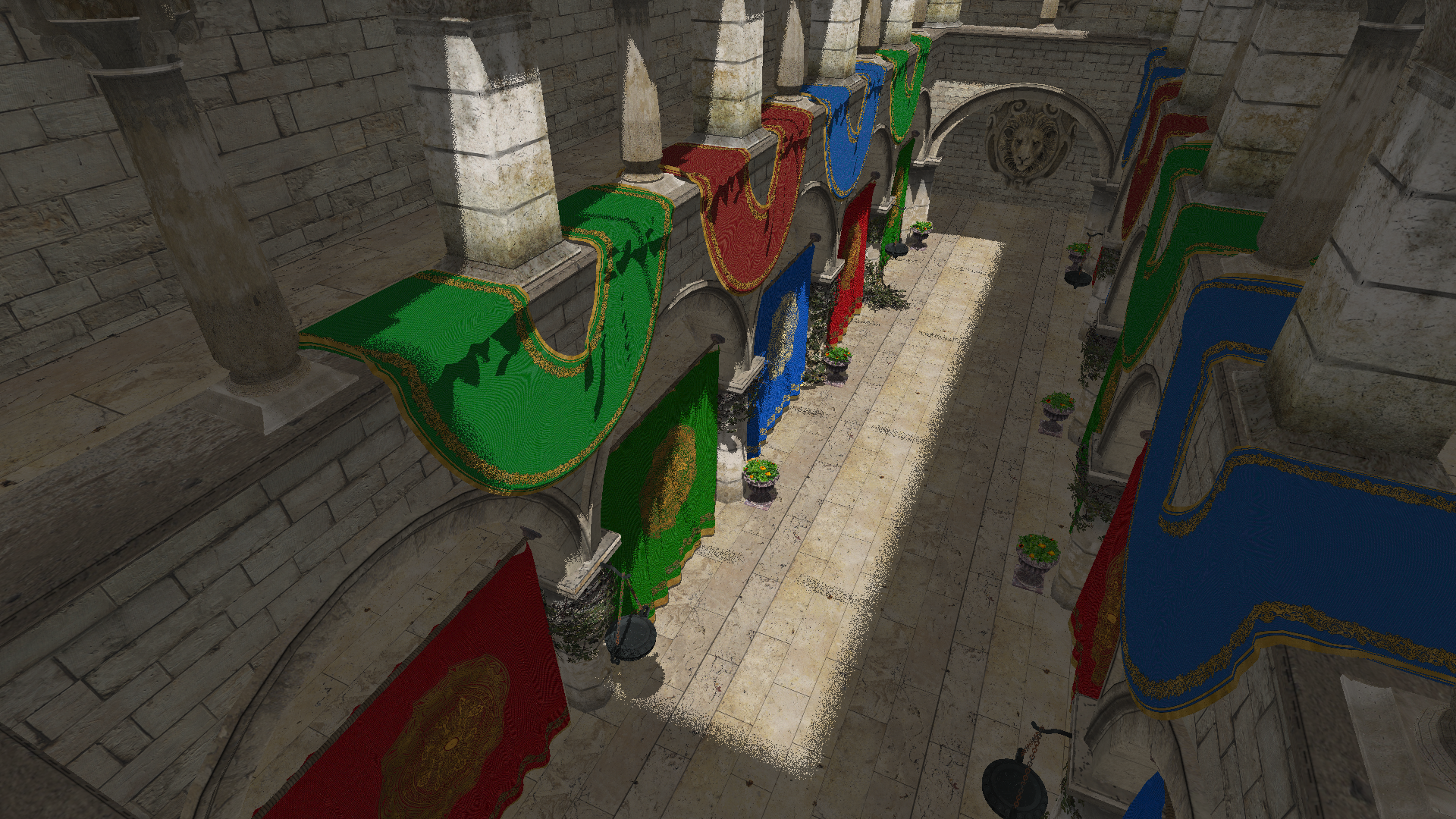
Shader system
The previous project already had a shader hot-reloading system in place, but it required you to compile the shaders before-hand, and then hot-reload the compiled shader binary code. I wanted to change this so that I could just press one button and have everything compile and hot-reload. I also wanted to play around with shader reflection, to automatically generate descriptor sets.
Shader compilation and reflection
I started with GLSL shaders which were compiled through shaderc, but eventually decided to switch over to HLSL shaders with the DirectX Shader Compiler.
After shaders are compiled, they get reflected with spirv_cross. A little bit of parsing later, this provides all sorts of useful information about a shader:
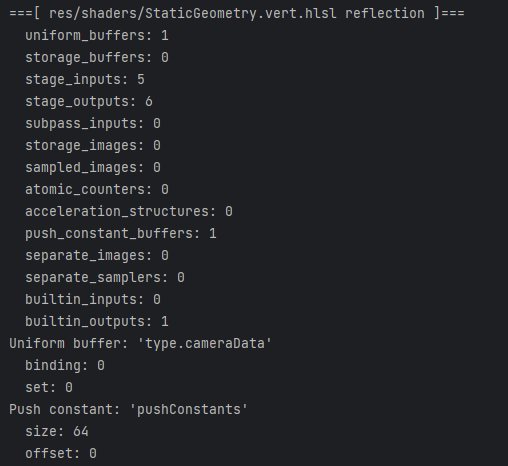
From this reflection data, descriptor set layouts are generated and push constant info structs are filled in. These are then used to create the descriptor sets and the graphics pipelines.
Sadly, the ray tracing shaders are a bit special and don’t work nicely with the reflection data, so I manually create the descrioptor sets for the ray tracing pipeline. Luckily my helper class makes this pretty painless:
m_DescLayout = DescriptorSetLayoutBuilder(m_pRenderCtx->device)
.AddBinding(
vk::DescriptorType::eAccelerationStructureKHR, // Type of descriptor
0, // Descriptor binding
1, // Descriptor count
vk::ShaderStageFlagBits::eRaygenKHR | vk::ShaderStageFlagBits::eClosestHitKHR // Shader stage flags
)
.AddBinding(vk::DescriptorType::eStorageImage, 1, 1, vk::ShaderStageFlagBits::eRaygenKHR)
.AddBinding(vk::DescriptorType::eUniformBuffer, 2, 1, vk::ShaderStageFlagBits::eRaygenKHR)
.Build();
Shader hot-reloading
If you want to reload a shader, you also have to re-create the pipeline it belongs to.
To handle this, I created the ShaderLibrary class, which manages all the shaders, and keeps track of their dependencies.
struct ShaderDependencies
{
std::vector<VulkanGraphicsPipeline*> graphicsPipelines;
std::vector<VulkanRayTracingPipeline*> rayTracingPipelines;
};
class ShaderLibrary
{
public:
// Constructor loads all the shaders.
ShaderLibrary(RenderContext* pRenderCtx);
// Pipelines register themselves as dependencies on the shaders that they use.
void RegisterShaderDependency(const UUID& shaderId, VulkanGraphicsPipeline* graphicsPipeline);
void RegisterShaderDependency(const UUID& shaderId, VulkanRayTracingPipeline* rtPipeline);
private:
std::unordered_map<std::string, std::unique_ptr<VulkanShader>> m_LoadedShaders;
std::unordered_map<UUID, ShaderDependencies> m_ShaderDependencies;
};
With this system in place, it’s rather easy to reload a shader and re-create their respective dependencies:
// Reload the shader from the latest version on disk.
pShader->Reload();
// Recreate all dependent graphics pipelines
for (VulkanGraphicsPipeline* graphicsPipeline : m_ShaderDependencies[pShader->GetId()].graphicsPipelines)
{
graphicsPipeline->Recreate();
}
// Recreate all dependent ray tracing pipelines
for (VulkanRayTracingPipeline* rtPipeline : m_ShaderDependencies[pShader->GetId()].rayTracingPipelines)
{
rtPipeline->Recreate();
}
Shader cache
Because recompiling all shaders on each startup was starting to take some time, I decided to implement a system to cache the compiled SPIR-V shaders. How this works is quite simple:
- First, I check when the shader file was last edited, and see if that shader has been cached with that timestamp.
- If it matches, I can simply load the contents of that binary shader file into memory and create a shader module with it.
- If it doesn’t match, or that shader has never been cached before, load the shader source code into a string, pass it to the HLSL or GLSL compiler, write the binary code to the cached file on disk and create a shader module with the shader code.
Improvements for the future
Of course nothing is ever finished, and I have a couple of things I want to improve on in the future:
- Implement PBR shading. For this I will likely have to move the ray tracing pass before the geometry pass so that I have the shadow information in time for the PBR shading. Alternatively I could work with a G-buffer that holds the albedo, normal and depth information, which I could then use to calculate the world-position in the ray tracing pass, to avoid tracing that first ray. However I will have to measure the performance and memory tradeoffs between the two ways to see which one is better.
- Add a denoiser for the ray traced shadows. Currently I’m thinking of implementing the FidelityFX Shadows Denoiser, as it seems to be doing everything I need.
- Implement more ray traced techniques, such as:
- Ambient Occlusion
- Reflections
- Global Illumination
Media
Here are some screenshots of the renderer in a variety of scenes:
(click on an image to view it in full-size)
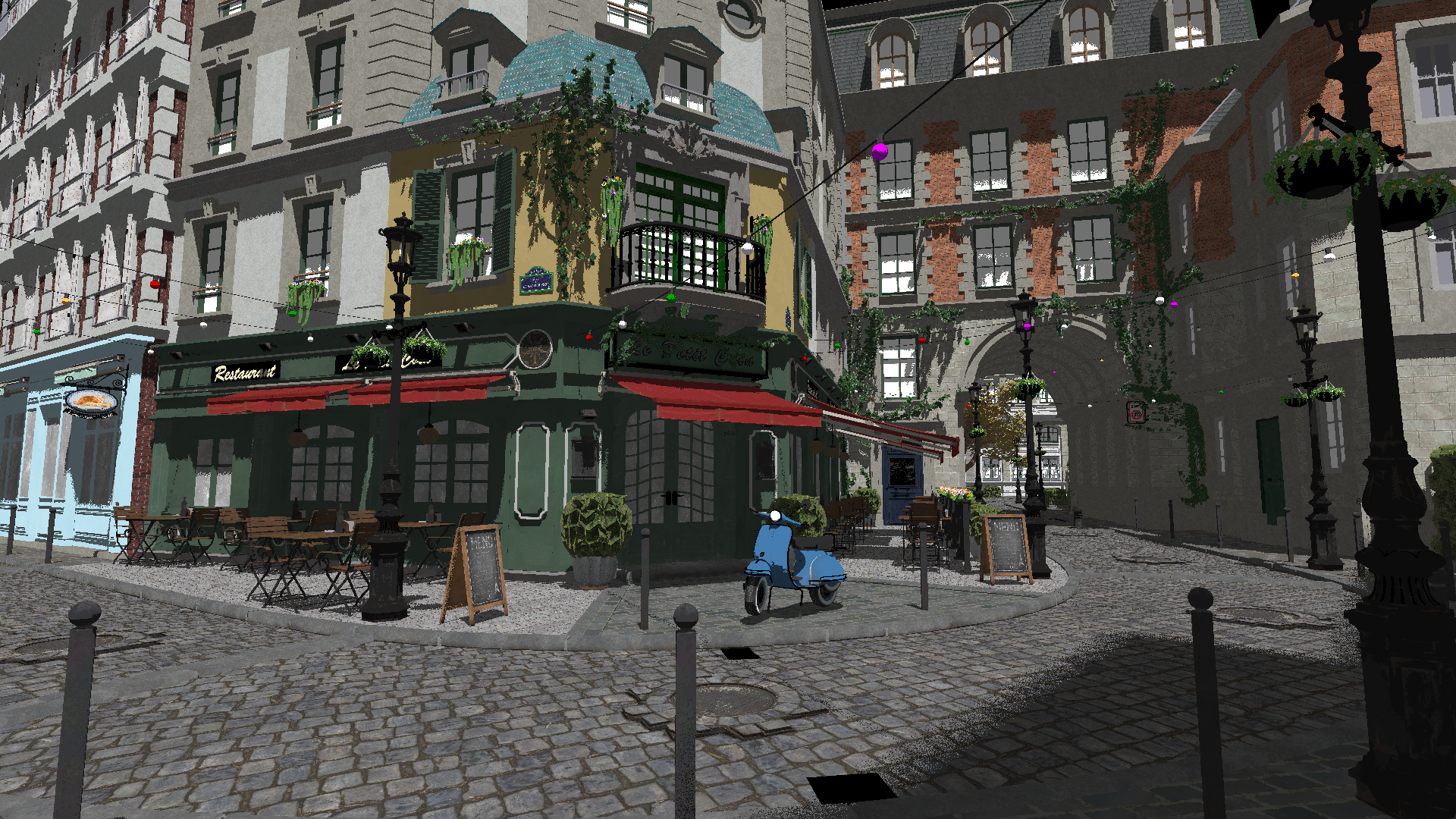
|
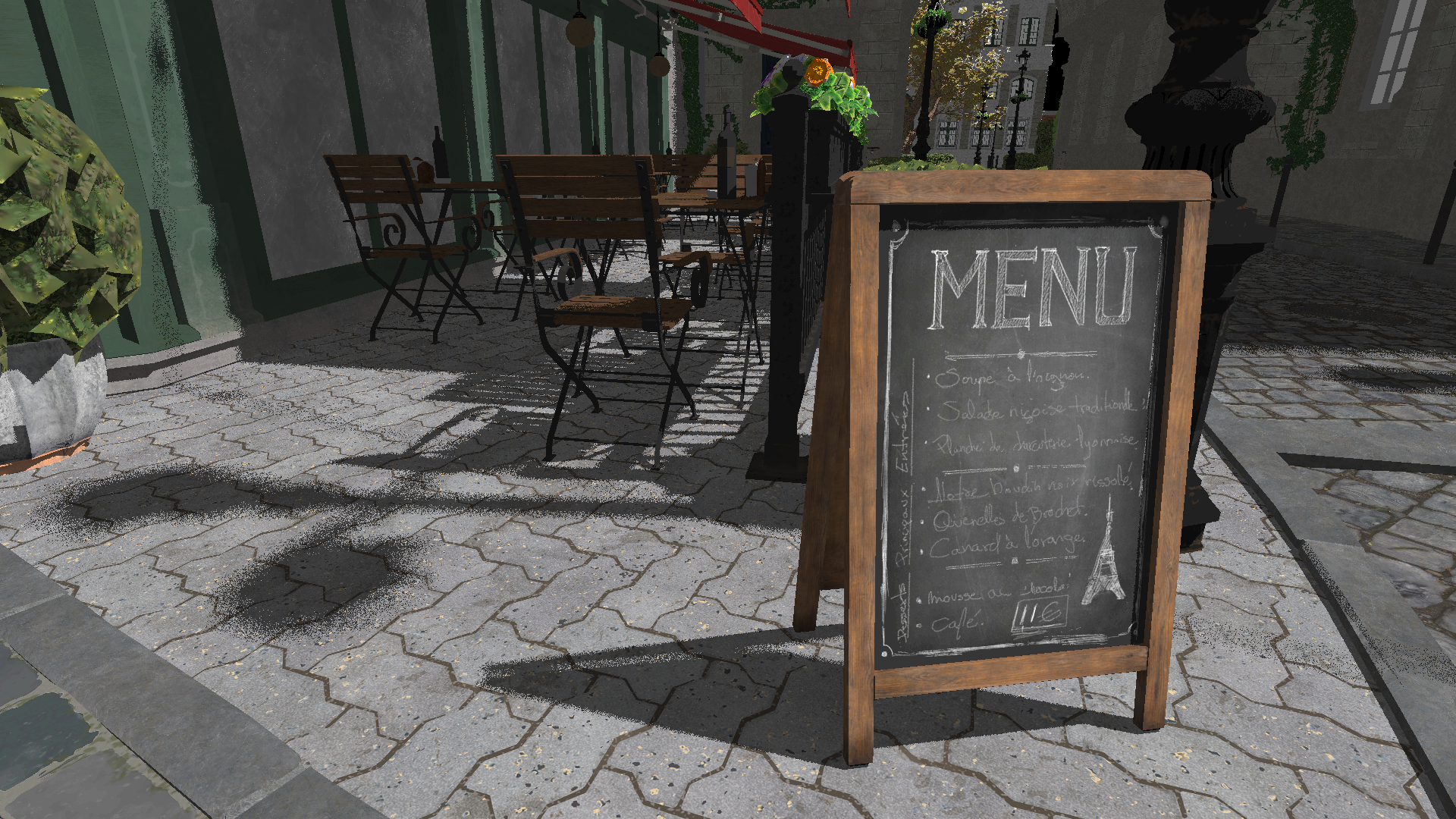
|
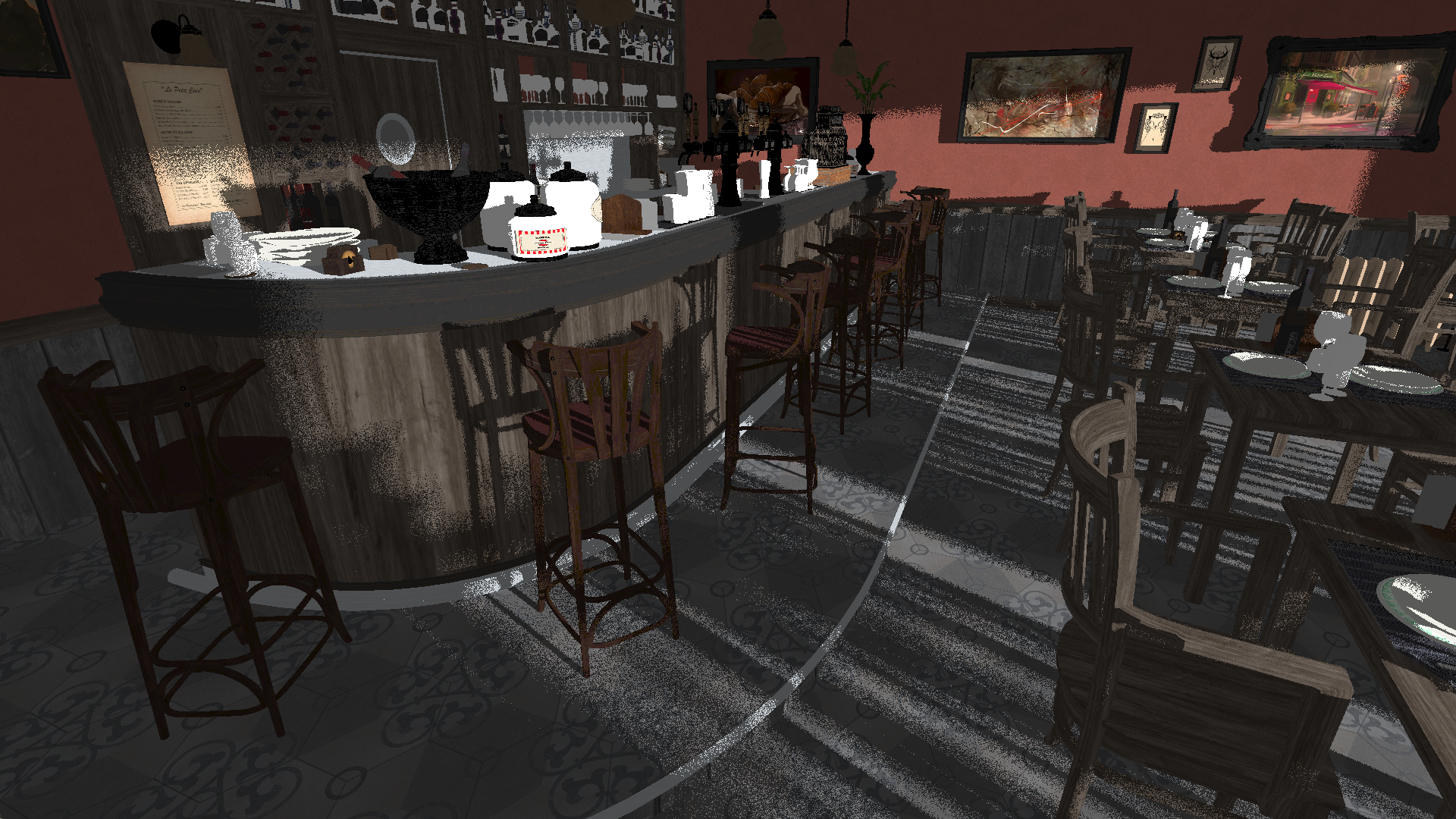
|
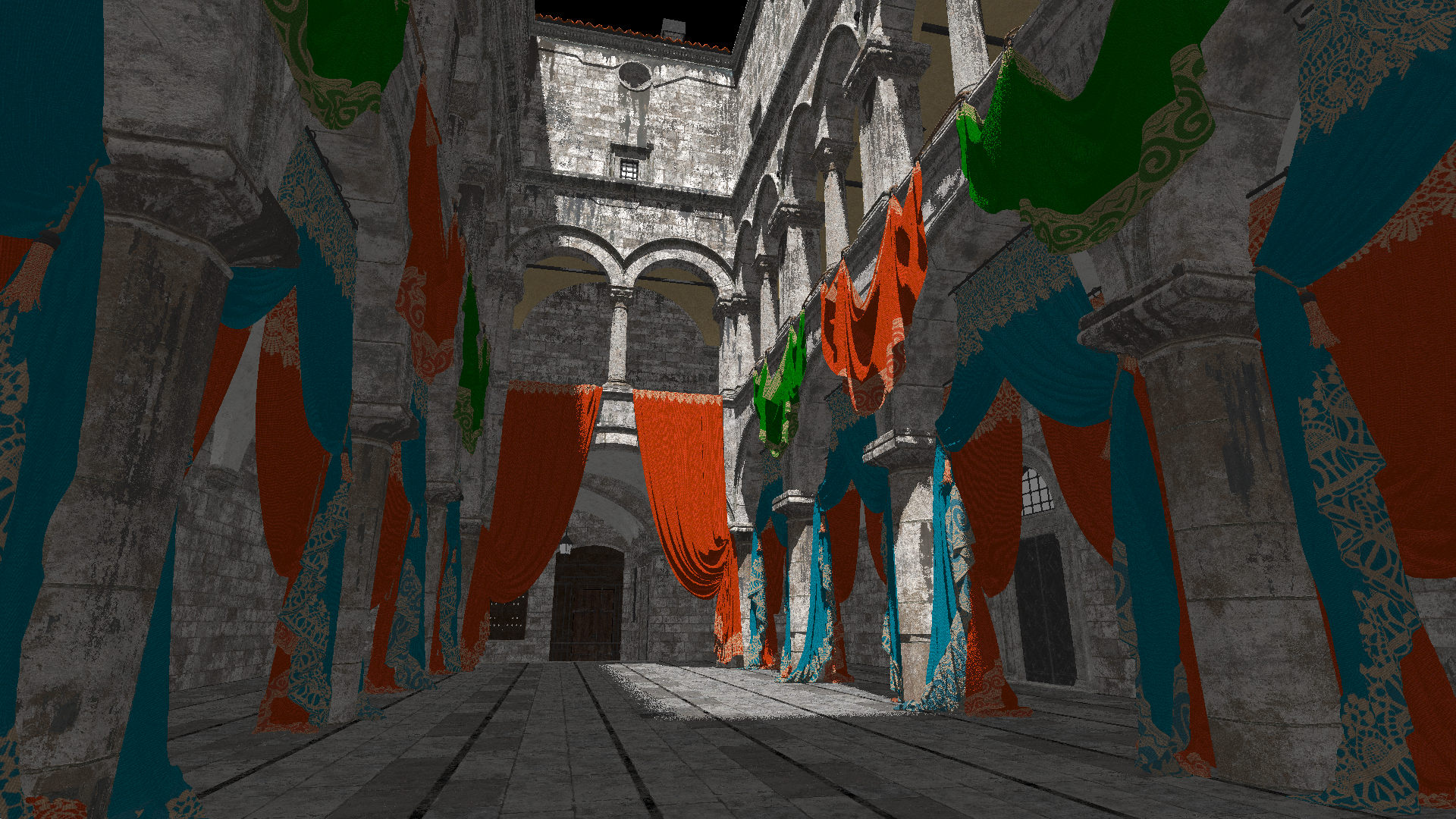
|
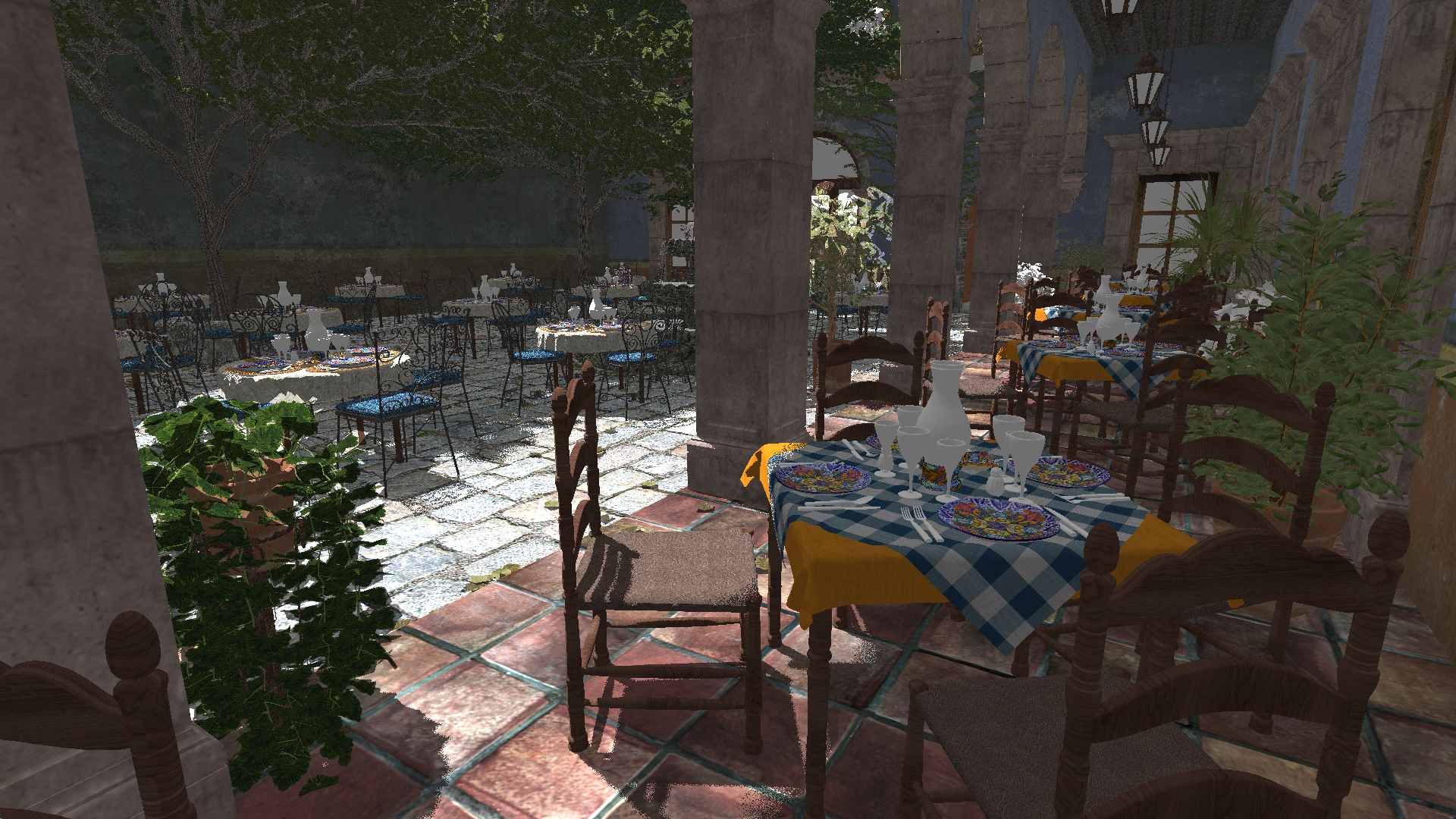
|

|
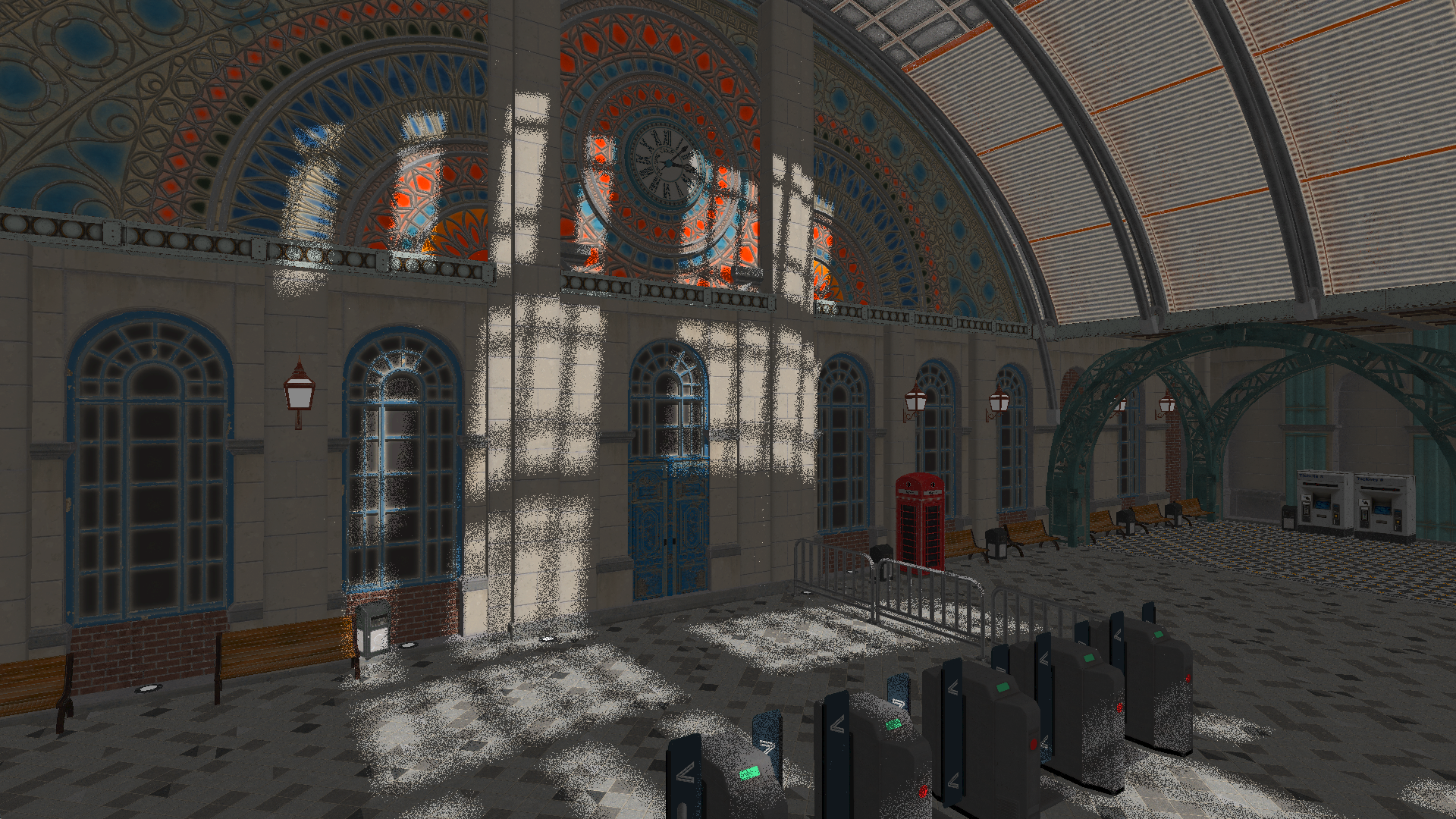
|

|
Project repository: https://github.com/SeppahBaws/Hyper